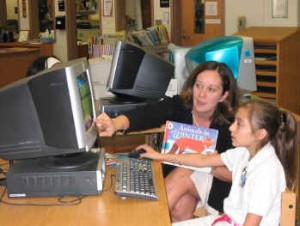
Technology is changing the face of education. Typing on a keyboard can make learning proper handwriting unimportant. Using a calculator can make simple math functions technology-assisted processes. And having a computer read aloud might someday allow non-readers to access the printed word.
I am not convinced that it is all bad. I do see eReaders as a possible instructional technology, not assistive technology. The term is no longer about a technology that takes the place of a particular academic skill, but instead makes independent learning easier.
For example, Amazon’s Kindle lets a person read a digital text, highlight difficult vocabulary, and look up the words on the same screen. It is like having a teacher right there to ask, “What does quixotic mean?”–but the student can use this feature on their own time.
How many more types of instructional technology are there, and should we be using them? Why are we asking the question, “How long can we hold out on this obsession of the younger generation?” instead of, “How soon can we meld this into our instruction?”
I left high school with the ability to word process and use a little of the emerging web. Inherent in that skill set were strong keyboarding skills and an understanding of how to cut and paste within a document. I would use spell check, word count, and occasionally grammar check. Now I am not sure that students even know these tools exist. The spelling errors are underlined in red on the screen or are corrected by word prediction features. Grammar errors are underlined in green, but the word processing tools do not teach proper grammar, they just give options to correct it, driving students further into their technology dependence.
More importantly, if a student goes to college with only an ability to word process, they might perish. Students must know how to use Excel for science labs, how to use PowerPoint proficiently, and how to search a school’s intranet, a library network, online databases of articles like Ebsco, Lexus-Nexus, and GoogleScholar. They need to know how to tell a hoax web site from a real one, how to scan a document into their computer, and how to cite internet, print, periodical, and image resources.
And maybe most important of all, they need to know how not to cheat. Upholding academic honesty in the age of the internet is increasingly difficult, and I find my students’ definition of “cheating” far more liberal than is mine.
Are we teaching students this extensive skill set, or merely hoping that because they use technology each day they will absorb what they need to know? Do we give enough attention to technology education, or are we too focused on keeping students off cell phones in class, away from social networking sites, and out of the distracting and distasteful corners of the web? This is only the beginning of our technology era, and we as educators need to condone proper usage, not condemn the institution of technology. It is our job as leaders to usurp the modes that seem only for pleasure and turn them into avenues for academic excellence. There is so much technology out there that we don’t consider academic technology. How are we going to use more of it to our advantage?
School principals across the country are attempting to incorporate technology into their classrooms. They are applying for federal stimulus money to purchase SMART Boards and trying to achieve 1-1 computing status in their classrooms. These purchases will put more technology in the classroom, driving home the point to our students that our world now relies on technology and that it is acceptable if they do as well.
I recently used a chat room in class to facilitate a class discussion, thinking little of the fact that we were all right there and could have been actually speaking to one another. How can I then turn around and be upset with the students who are instant messaging across the classroom, texting with students in other classes, or tweeting about the class? Haven’t I used technology in a way that seems to promote this type of behavior? I meant to deliver a lesson using contemporary modes of communication, but I delivered a mixed message about appropriate use of technology.
Too little money is being put towards educating teachers on how to incorporate technology into their lessons, how to use technology to stay connected with their students, and how to encourage students to use technology in academic settings as readily as they do in their social lives. As an educator, I am unprepared to incorporate technology to the level that I believe would engage my students to embrace it as a viable academic tool. I need training, models, and encouragement, not just the latest tools, and I believe this is what my students need as well.
Michael Hildebrandt holds a master’s degree in special education and is a certified teacher of students with moderate disabilities. He currently teaches study skills, instructs language arts tutorials, and writes grants for Landmark School in Beverly, Massachusetts, which serves students with language-based learning disabilities.
- 4 ways to support work-based learning - April 23, 2024
- Prioritizing inclusivity in game-based learning - April 22, 2024
- Friday 5: Universal Design for Learning - April 19, 2024

